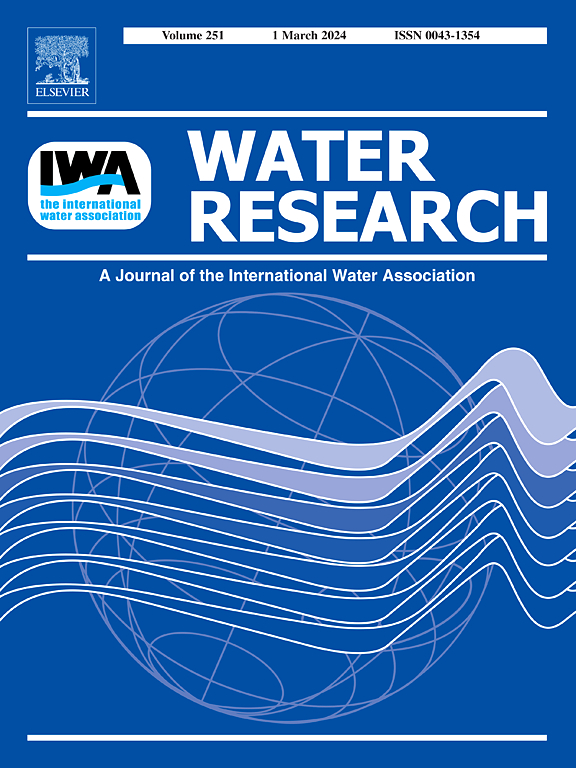Methylsiloxanes in drinking water treatment plants: Occurrence, removal efficiencies and exposure risks across multiple stages of treatment process development
IF 12.4
1区 环境科学与生态学
Q1 ENGINEERING, ENVIRONMENTAL
引用次数: 0
Abstract
Methylsiloxanes (MSs) are recognized as emerging pollutants and have been widely detected in surface waters that serve as drinking water sources. However, their removal efficiencies through various processes in drinking water treatment plants (DWTPs) remain poorly understood. The present study determined 17 MSs including 8 cyclic MSs (CMSs), 7 linear MSs (LMSs) and two hydride-terminated MSs (HDMSs) in 8 DWTPs which represented 4 typical treatment processes. In source water samples, 16 MSs were frequently detected, and the highest concentrations were observed in river network waters with the lowest ones in reservoir-derived waters. In the samples from DWTPs, the average total concentrations ranged from 34.2 to 147 ng/L for CMSs, 1.55 to 42.7 ng/L for LMSs and 14.1 to 133 ng/L for HDMSs, respectively. In each DWTP type, the total concentrations followed an order of CMSs > HDMSs > LMSs. The MSs can’t be completely removed by the DWTPs, with overall removal efficiencies ranging from 23.1 %∼63.7 % for CMSs, -58.9 %∼27.4 % for LMSs and 37.6 %∼87.2 % for HDMSs, respectively. In conventional DWTPs, disinfection functioned as the primary removal mechanism for MSs. In DWTPs with ozonation-biological activated carbon (O3-BAC), both oxidation by O3 and the disinfection contributed to the efficient removal. In DWTPs with pre-ozonation (or pre-chlorination), the O3-BAC remained the key effective treatment step, while the disinfection showed negative contribution to the removal. The DWTPs with the artificial wetland or biological pretreatment with advanced processes including O3-BAC, ultrafiltration (UF) and nanofiltration (NF) showed the highest removal efficiencies. The total average daily doses (ADDs) were below the corresponding chronic reference dose (RfD) values, suggesting low health risks. Further investigations on both toxicities and fates of these MSs are still necessary to strengthen health protection strategies.


饮用水处理厂中的甲基硅氧烷:处理过程发展多个阶段的发生、去除效率和暴露风险
甲基硅氧烷(MSs)是公认的新兴污染物,在作为饮用水源的地表水中被广泛检测到。然而,在饮用水处理厂(DWTPs)中,通过各种工艺去除它们的效率仍然知之甚少。本研究在8个dwtp中测定了17个MSs,包括8个环状MSs (cms), 7个线性MSs (lms)和2个氢化物终止MSs (HDMSs),代表了4种典型的处理工艺。在水源水样中,经常检测到16种MSs,其中河网水的浓度最高,水库水源水的浓度最低。在dwtp的样品中,cms的平均总浓度为34.2至147 ng/L, lms的平均总浓度为1.55至42.7 ng/L, hdms的平均总浓度为14.1至133 ng/L。在每种DWTP类型中,总浓度依次为cms >;HDMSs祝辞lms。dwtp不能完全去除MSs,其总体去除效率分别为cms的23.1% ~ 63.7%、lms的-58.9% ~ 27.4%和hdms的37.6% ~ 87.2%。在传统的dwtp中,消毒是去除MSs的主要机制。在臭氧氧化-生物活性炭(O3- bac)的dwtp中,O3氧化和消毒都有助于高效去除。在预臭氧化(或预氯化)的dwtp中,O3-BAC仍然是关键的有效处理步骤,而消毒对去除率的贡献为负。采用人工湿地或采用O3-BAC、超滤、纳滤等先进工艺进行生物预处理的dwtp去除率最高。总平均每日剂量(add)低于相应的慢性参考剂量(RfD)值,表明健康风险较低。为了加强健康保护战略,仍有必要进一步调查这些ms的毒性和命运。
本文章由计算机程序翻译,如有差异,请以英文原文为准。
求助全文
约1分钟内获得全文
求助全文
来源期刊

Water Research
环境科学-工程:环境
CiteScore
20.80
自引率
9.40%
发文量
1307
审稿时长
38 days
期刊介绍:
Water Research, along with its open access companion journal Water Research X, serves as a platform for publishing original research papers covering various aspects of the science and technology related to the anthropogenic water cycle, water quality, and its management worldwide. The audience targeted by the journal comprises biologists, chemical engineers, chemists, civil engineers, environmental engineers, limnologists, and microbiologists. The scope of the journal include:
•Treatment processes for water and wastewaters (municipal, agricultural, industrial, and on-site treatment), including resource recovery and residuals management;
•Urban hydrology including sewer systems, stormwater management, and green infrastructure;
•Drinking water treatment and distribution;
•Potable and non-potable water reuse;
•Sanitation, public health, and risk assessment;
•Anaerobic digestion, solid and hazardous waste management, including source characterization and the effects and control of leachates and gaseous emissions;
•Contaminants (chemical, microbial, anthropogenic particles such as nanoparticles or microplastics) and related water quality sensing, monitoring, fate, and assessment;
•Anthropogenic impacts on inland, tidal, coastal and urban waters, focusing on surface and ground waters, and point and non-point sources of pollution;
•Environmental restoration, linked to surface water, groundwater and groundwater remediation;
•Analysis of the interfaces between sediments and water, and between water and atmosphere, focusing specifically on anthropogenic impacts;
•Mathematical modelling, systems analysis, machine learning, and beneficial use of big data related to the anthropogenic water cycle;
•Socio-economic, policy, and regulations studies.
 求助内容:
求助内容: 应助结果提醒方式:
应助结果提醒方式:


